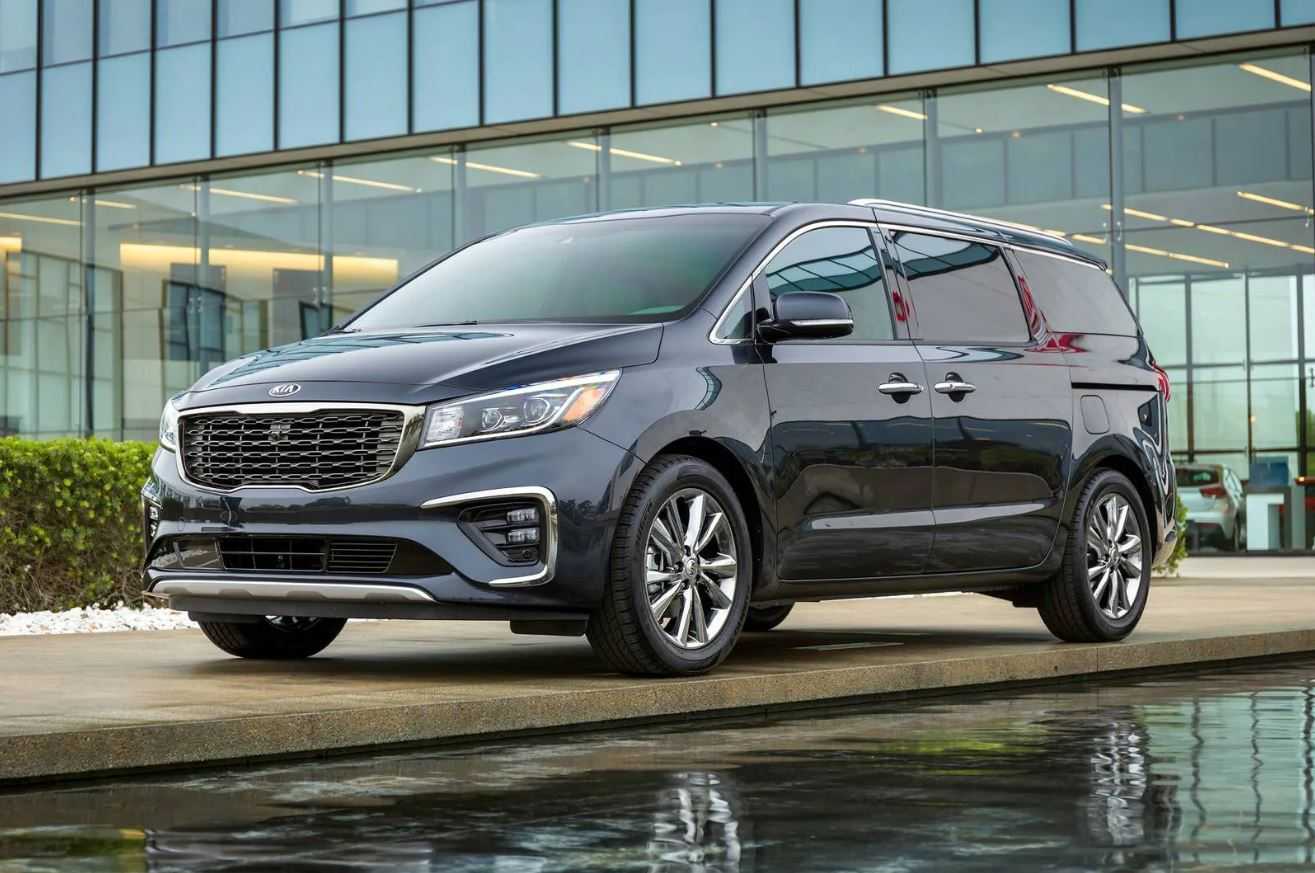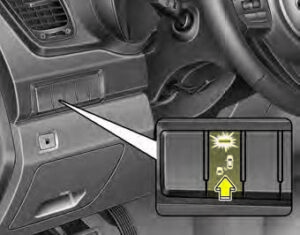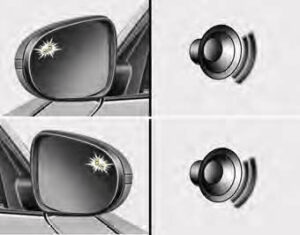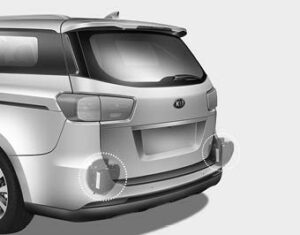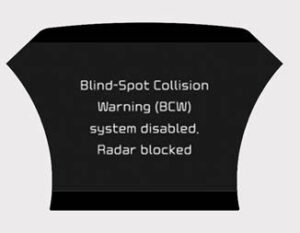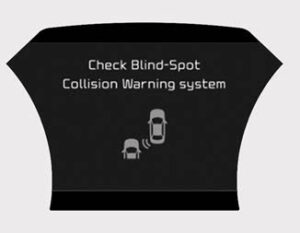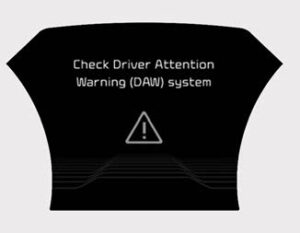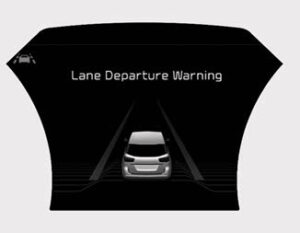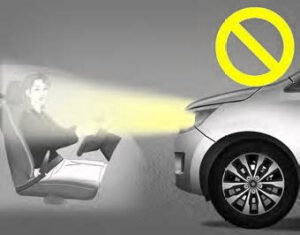Kia Sedona 2020 Blind-spot Collision Warning User Manual
Introduction
Blind-spot Collision Warning (BCW) is an advanced safety feature available on the Kia Sedona 2020. This technology is intended to improve driver awareness and aid in the prevention of accidents caused by vehicles in the blind spots. The BCW system monitors areas alongside and behind the vehicle that are typically difficult to see through the side mirrors or rearview mirror alone. The BCW system can detect the presence of vehicles entering the blind spots by continuously scanning these zones.
Kia Sedona 2020 drivers can enjoy increased confidence and peace of mind on the road with Blind-spot Collision Warning, knowing that they have an extra layer of protection against potential blind-spot accidents. Kia continues to prioritize driver safety by incorporating advanced safety technologies such as BCW, making driving safer and more secure for everyone on the road.
ACTIVE ECO SYSTEM
Active ECO operation
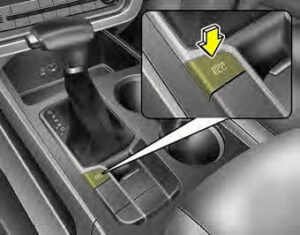
ECO
Active ECO helps improve fuel efficiency by controlling the engine and transmission. But fuel-efficiency can be affected by the driver’s driving habits and road conditions.
- When the Active ECO button is pressed the ECO indicator (green) will illuminate to show that the Active ECO is operating.
When the Active ECO is activated, it does not turn off even though the engine is restarted again. To turn off the system, press the active ECO button again.
If Active ECO is turned off, it will return to the normal mode.
When Active ECO is activated:
- The engine noise may get louder.
The vehicle speed may slightly be reduced.
The air conditioner performance may be affected.
Limitation of Active ECO operation:
If the following conditions occur while Active ECO is operating, the system operation is limited even though there is no change in the ECO indicator.
- When the coolant temperature is low:
The system will be limited until engine performance becomes nor-mal.
When driving up a hill:
The system will be limited to gain power when driving uphill because the engine torque is restricted.
When using sports mode:
The system will be limited according to the shift location.
When the accelerator pedal is deeply pressed for a few seconds: The system will be limited, as it has determined that the driver has accelerated judging that the driver wants to speed up.
DRIVE MODE INTEGRATED CONTROL SYSTEM (IF EQUIPPED)
DRIVE mode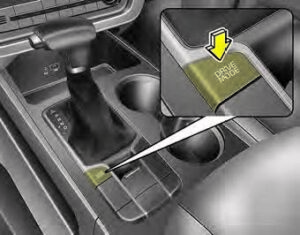
The drive mode may be selected according to the driver’s preference or road condition.
The mode changes whenever the DRIVE MODE button is pressed.
When normal mode is selected, it is not displayed on the cluster.
ECO mode (Active ECO)
Active ECO helps improve fuel efficiency by control-ling certain engine and transmission operating system parameters.
Fuel efficiency depends on the driver’s driving habits and road condition.
- When the DRIVE MODE button is pressed and the ECO mode is selected, the ECO indicator (green) will illuminate to show that the Active ECO is operating.
When the Active ECO is activated, it does not turn off even though the engine is restarted again. To turn off the system, press the DRIVE MODE button again.
When Active ECO is activated:
- The acceleration may slightly be reduced even though you depress the accelerator fully.
The air conditioner performance may be limited
The shift pattern of the automatic transmission may change.
The engine noise may get louder.
The above situations are normal conditions when the active eco system is activated to improve fuel efficiency.
Limitation of Active ECO operation:
If the following conditions occur while Active ECO is operating, the system operation is limited even though there is no change in the ECO indicator.
- When the coolant temperature is low:
The system will be limited until engine performance becomes nor-mal.
When driving up a hill:
The system will be limited to gain power when driving uphill because the engine torque is restricted.
When using manual mode:
The system will be limited according to the shift location.
When the accelerator pedal is deeply depressed for a few seconds:
The system will be limited, judging that the driver wants to speed up.
Comfort mode
The steering wheel becomes lighter. The com-fort mode is usually used when driving in the city or when parking the vehicle.
- For your safety, if you press the steering mode button while operating the steering wheel, but the steering effort will not change immediately. After operating the steering wheel, the steering will change automatically to the selected mode.
- When the electronic power steering is not operating properly, the flex steering wheel will not work.
CAUTION
Use caution when changing the steering mode while driving.
BLIND-SPOT COLLISION WARNING (BCW) / REAR CROSS-TRAFFIC COLLISION WARNING (RCCW) (IF EQUIPPED)
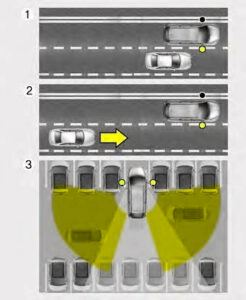
The Blind-Spot Collision Warning (BCW) system uses radar sensors in the rear bumper to monitor and warn the driver of an approaching vehicle in the driver’s blind spot area.
The system monitors the rear area of the vehicle and provides information to the driver with an audible alert and a indicator on the outside rearview mirrors
- Blind spot area
The warning range is dependent on your vehicle speed. Note that if your vehicle is traveling much faster than other nearby vehicles, the warning will not occur. - Closing at high speed
The BCW-Closing at high speed feature will alert you when a vehicle is approaching in an adjacent lane at a high rate of speed. If the driver activates the turn signal when the system detects an oncoming vehicle, the system sounds an audible alert. - Rear Cross-Traffic Collision Warning (RCCW)
The RCCW feature monitors approaching cross traffic from the left and right side of the vehicle when your vehicle is in reverse. The feature will operate when the vehicle is moving in reverse below about 6 mph (10 km/h). If oncoming cross traffic is detected a warning chime will sound.
WARNING
BCW Limitations
- The Blind-Spot Collision Warning System (BCW) is a supplemental system. Do not solely rely on the system and always pay attention to drive safely.
The Blind-Spot Collision Warning System may not detect every object alongside the vehicle and is not a substitute for proper and safe lane changing procedures. Always drive safely and use caution when changing lanes.
BCW (Blind-Spot Collision Warning)
Operating conditions
- The indicator on the switch will illuminate when the Blind-Spot Collision Warning System (BCW) switch is pressed with the engine start/stop Button ON.
If vehicle speed exceeds 20 mph (30 km/h), the system will activate.
If you press the switch again, the switch indicator and system will be turned off. - If the vehicle is turned off, the system will remember the last settings upon restart.
When the system is not used turn the system off by turning off the switch.
When the system is turned on the warning light will illuminate for 3 seconds on the outside rearview mirror.
Warning type
The system will activate when:
- The system is on.
- Vehicle speed is above 20 mph (30 km/h).
- Other vehicles are detected in blind spot.
WARNING
The Blind-Spot Collision Warning System and Rear Cross-Traffic Collision Warning is not a substitute for proper and safe lane changing procedures. Always drive safely and use caution when changing lanes. The Blind-Spot Collision Warning System may not detect every object alongside the vehicle.

- If a vehicle is detected within the boundary of the system, a warning light will illuminate on the outside rearview mirror.
If the detected vehicle is not in detecting range, the warning will turn off.
The second stage alarm will activate when:
- The first stage alert is on
- The turn signal is on to change a lane
When the second stage alert is activated, a warning light will blink on the outside rearview mirror and an alarm will sound.
If you move the turn signal switch to the original position, the second stage alert will be deactivated.
The second stage alarm may be deactivated.
- To activate the alarm:
Go to the User Settings Mode → Driver Assistance and select “Blind-Spot Collision Warning” on the LCD display. - To deactivate the alarm:
Go to the User Settings Mode → Driver Assistance and deselect “Blind-Spot Collision Warning” on the LCD display.
NOTICE
The alarm function helps alert the driver. Deactivate this function only when it is necessary
CAUTION
When other warning alarms such as the seat belt warning sound are in operation and
override the BCW alarming system, BCW warning sound may not occur.
Detecting sensor
The sensors are located inside of the rear bumper.
Always keep the rear bumper clean for the system to work properly.
WARNING
- The warning light on the out-side rearview mirror will illuminate whenever a vehicle is detected at the rear side by the system. To avoid accidents, do not focus only on the warning light and neglect to see the surrounding of the vehicle.
Drive safely even though the vehicle is equipped with a Blind-Spot Collision Warning System (BCW). Do not solely rely on the system but check your surroundings before changing lanes or backing the vehicle up. The Blind-Spot Collision Warning system (BCW) may not detect every object alongside the vehicle.
The system may not alert the driver in some situations due to system limitations so always check your surroundings while driving.
Rear Cross-Traffic Collision Warning (RCCW)

- When your vehicle moves backwards from a parking position, the RCCW system detects approaching cross traffic from the left and right side of the vehicle and warns to driver.
The blind spot detection range varies relative to the approaching vehicle speed.
Operating conditions
- Select RCCW (Rear Cross-Traffic Collision Warning) in “User Settings” under “Driver Assistance” on the instrument cluster. The system will turn on and standby to activate.
- Select RCCW again, to turn the system off.
If the vehicle is turned off, the RCCW system will remember the last settings upon restart. Always turn the RCCW system off when not in use. - The system operates when the vehicle speed is below 6 mph (10km/h) with the shift lever in R (Reverse).
The RCCW (Rear Cross-Traffic Collision Warning) detecting range is 1.6 feet ~ 65 feet based on the side direction. If the approaching vehicle speed is 2.5 mph (4 km/h) ~ 22 mph (36 km/h) within sensing range, it is detected. However, the system sensing range can vary based on conditions. Always pay attention to your surroundings.
Warning type
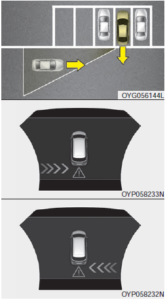
- If the vehicle detected by sensors approaches your vehicle, the warning chime will sound and the warning light will blink on the outside rearview mirror.
If the detected vehicle is out of detection range, moving away in the opposite direction or moving slow, or if the vehicle is right behind your vehicle, the warning is cancelled.
The system may not operate properly due to other factors or circum-stances. Always pay attention to your surroundings.
CAUTION
When other warning sounds such as the seat belt warning sound are in operation and override the RCCW alarming system, RCCW warning alarm may not occur.
If your vehicle’s left or right side bumper is blinded by a barrier or vehicles, the system sensing ability may not function properly.
WARNING
- The Blind-Spot Collision Warning System and Rear Cross-Traffic Collision Warning is not a substitute for proper and safe lane changing procedures. Always drive safely and use caution when changing lanes. The Blind-Spot Collision Warning System may not detect every object alongside the vehicle.
- Drive safely even though the vehicle is equipped with a BCW (Blind-Spot Collision Warning) system. Do not solely rely on the system but check for your-self before changing lanes. The system may not alert the driver in some conditions so always check the surroundings while driving.
When the BCW system is being activated, the warning light on the outside rearview mirror will illuminate whenever a vehicle is detected at the rear side by the system. To avoid accidents, do not focus only on the warning light and neglect to see the surrounding of the vehicle.
NOTICE
- The system may not work properly if the bumper has been replaced or if repair work has been done near the sensor.
The detection area differs according to the road’s width. If the road is narrow the system may detect other vehicles in the next lane.
If the road is very wide the system may not detect other vehicles.
The system may turn off due to strong electromagnetic interference.
Warning message
The message will appear to notify the driver if there are foreign sub-stances on the surface or inside the rear bumper or it is hot near the rear bumper. The light on the switch and the system will be turned off automatically.
Remove the foreign substance on the rear bumper.
After the foreign substance is removed, if you drive for approximately 10 minutes, the system will work normally.
If the system does not work normally even though the foreign substance, trailer or carrier, or other equipment is removed, have the system checked by an authorized Kia dealer.
It is possible to get the message with no foreign substance on the rear bumper, for example, when driving in sparse rural or open area, such as desert, where there is insufficient data for operation.
This message may also activate during heavy rain or due to road spray.
When the cargo area or other equipment is being used, turn all functions of the system [OFF].
If the system does not work properly, a warning message will appear and the light on the switch will turn off. The system will turn off automatically.
We recommend that the system be checked by an authorized Kia dealer.
Non-operating condition
Outside rearview mirror may not alert the driver when:
- The outside rearview mirror housing is damaged or covered with debris.
The window is covered with debris.
The windows are severely tinted.
Limitations of the system
The driver must be cautious in the below situations, because the system may not detect other vehicles or objects in certain circumstances.
- The vehicle drives on a curved road or through a tollgate.
The sensor is covered with rain, snow, mud, etc.
The rear bumper, in which the sensor is located, is covered or blocked with a foreign matter such as a sticker, a bumper guard, a bicycle stand, etc.
The rear bumper is damaged, or the sensor is out of the original default position.
The vehicle height gets lower or higher due to heavy loading in a liftgate, abnormal tire pressure, etc.
The vehicle drives in inclement weather such as heavy rain or snow.
There is a fixed object near the vehicle, such as a guardrail, pedestrian, animal, tunnel, etc. - A big vehicle is near such as a bus or truck.
A motorcycle or bicycle is near.
A flat trailer is near.
If the vehicle has started at the same time as the vehicle next to you and has accelerated.
When the other vehicle passes at a very fast speed.
While changing lanes.
When going down or up a steep road where the height of the lane is different.
When the other vehicle approaches very close.
When a trailer or carrier is installed.
When the temperature of the rear bumper is very high or low.
When the sensors are blocked by other vehicles, walls or parking-lot pillars.
When the detected vehicle also moves back, as your vehicle drives back. - If there are small things like a shopping cart or baby carriage.
If there is a low height vehicle.
When other vehicles are close to your vehicle.
When the vehicle in the next lane moves two lanes away from you OR when the vehicle two lanes away moves to the next lane from you.
When driving through a narrow road with many plants.
When driving on wet surface.
The vehicle is driven near areas containing metal substances such as a construction zone, railroad, etc.
When the surrounding vehicle or structure is driving in a wide area (desert, field, suburb etc.)
This device complies with Part 15 of the FCC rules.
Operation is subject to the following three conditions:
- This device may not cause harmful interference, and
- This device must accept any interference received, including interference that may cause undesired operation.
- Changes or modifications not expressly approved by the party responsible for compliance could void the user’s authority to operate the device.
Radio frequency radiation expo-sure information:
This equipment complies with FCC radiation exposure limits set forth for an uncontrolled environment.
This equipment should be installed and operated with minimum distance of 20 cm between the radiator (antenna) and your body.
This transmitter must not be collocated or operating in conjunction with any other antenna or transmitter.
DRIVER ATTENTION WARNING (DAW) (IF EQUIPPED)
The Driver Attention Warning (DAW) system is designed to warn the driver of potentially hazardous driving situations if it detects inattentive driving practices.
System setting and activation System setting
- To turn ON the Driver Attention Warning system, turn on the engine, and then select ‘User Settings → Assist → Driver Attention Warning → Normal/Early’ on the LCD display.
The driver can select the Driver Attention Warning system mode.- Off : The Driver Attention Warning system is deactivated.
- Normal : The Driver Attention Warning system alerts the driver of his/her inattentive driving practices.
- Early : The Driver Attention Warning system alerts the driver of his/her inattentive driving practices faster than Normal mode.
- The set-up of the Driver Attention Warning system will be maintained when the engine is re-started.
Display of the driver’s attention level

-
- Select ‘User Settings Mode’ and then ‘Assist’ on the LCD display.(For more information, refer to “LCD Display” in chapter 4.)
- The driver’s attention level is dis-played on the scale of 1 to 5. The lower the number is, the more inattentive the driver is.
The number decreases when the driver does not take a break for a certain period of time.
The number increases when the driver attentively drives for a certain period of time.
When the driver turns on the system while driving, it displays ‘Last Break time’.
Take a break
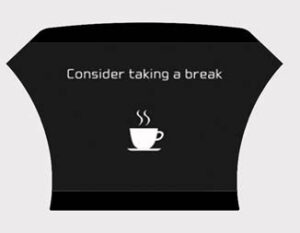
- The “Consider taking a break” message appears on the LCD display and a warning sounds to suggest that the driver take a break when the driver’s attention level is below 1.
The Driver Attention Warning system will not suggest a break when the total driving time is shorter than 10 minutes.
CAUTION
When other warning sounds such as the seat belt warning sound are in operation and
override the DAW alarming system, DAW warning sounds may not occur.
Resetting the system
- The last break time is set to 00:00 and the driver’s attention level is set to 5 (very attentive) when the driver resets the Driver Attention Warning system.
The driver attention warning system resets in the following situations.- The engine is turned OFF.
- The driver unfastens the seat belt and then opens the driver’s door.
- The driver takes a break from driving that lasts more than 10 minutes.
- The driver attention warning system operates again when the driver restarts driving.
System standby
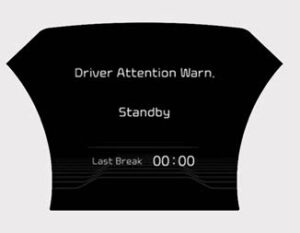
- The Driver Attention Warning system enters the ready status and displays the ‘Standby’ screen in the following situations.
- The camera sensor is unable to detect the lanes.
- Driving speed remains under 40 mph (110 km/h) or over 110 mph (177 km/h).
System malfunction
When the “Check Driver Attention Warning (DAW) system” warning message appears, the system is not working properly. In this case, have the vehicle inspected by an authorized Kia dealer.
WARNING
The Driver Attention Warning system is not a substitute for safe driving practices, but a convenience function only. It is the responsibility of the driver to always drive cautiously to prevent unexpected and sudden situations from occurring. Pay attention to the road conditions at all times.
NOTICE
- It may suggest a break according to the driver’s driving pattern or habits even if the driver doesn’t feel fatigued.
The driver, who feels fatigued, should take a break, even though there is no break suggestion by the Driver Attention Warning system.
NOTICE
The Driver Attention Warning system utilizes the camera sensor on the front windshield for its operation. To keep the camera sensor in the best condition, you should observe the followings:
- Do not place any reflective objects (i.e. white paper, mirror) over the dashboard. Any light reflection may prevent the Driver Attention Warning (DAW) system from functioning properly.
Pay extreme caution to keep the camera sensor dry.
Do not disassemble the camera assembly, or apply any impact on the camera assembly.
Playing the vehicle audio system at high volume may prevent the occupants from hearing the Driver Attention Warning system warning sounds.
CAUTION
The Driver Attention Warning system may not provide alerts in the following situations:
- The lane detection performance is limited. (For more information, refer to “Lane Departure Warning (LDW) system” in this chapter.)
Rough or intentionally evasive driving
Large tire pressure deviation, uneven wear, poor wheel alignment, etc.
Severe winding road
Uneven road surface condition
The vehicle is controlled by the following driving assist systems:- Forward Collision-Avoidance Assist (FCA) System
- Smart Cruise Control (SCC) System
LANE DEPARTURE WARNING (LDW) SYSTEM (IF EQUIPPED)
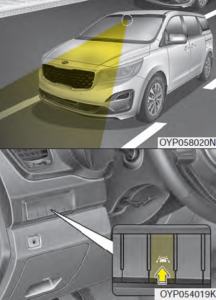
Lane Departure Warning system detects the lane with a front view camera at the front windshield and warns you when your vehicle departs from the lane.
WARNING
- Driver is responsible for being aware of surroundings and safely steering the vehicle.
- The LDW does not make the vehicle change lanes or stay in the lane.
Do not turn the steering wheel suddenly if the LDW warns that your vehicle is leaving the lane. - If the a front view camera can-not detect the lane or if the vehicle speed does not exceed 40 mph (64 km/h), the LDW will not be able to notify you if the vehicle leaves the lane.
When you replace the wind-shield glass or front view camera, take your vehicle to an authorized Kia dealer and have the system checked to need a calibration. - Do not allow any water or liquid to contact the front view camera.
Do not remove the LDW parts and do not make strong impact on the camera.
Do not put objects that reflect light on the dashboard.
You may not hear warning sounds from the LDW system if the audio volume is excessively high.
LDW Operation
To activate/deactivate the LDW:
With the ignition switch in the ON position, press the LDW button located on the instrument panel on the lower left hand side of the driver.
The indicator in the cluster display will initially illuminate white.
If the indicator (white) was activated in the previous ignition cycle, the system turns on automatically.
If you press the LDW button again, the indicator on the cluster display will go off.
The color of indicator will change depend on the condition of LDW.
- White : Sensor does not detect the lane marker or vehicle speed is less than 40 mph (64 km/h).
Green : Sensor detects the lane marker. 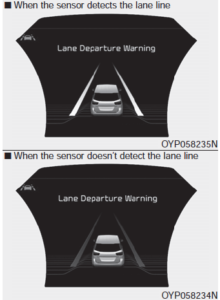
If the vehicle leaves the lane when the LDW operates and vehicle speed exceeds 40 mph (64 km/h), the warning is issued as follows:

- Visual warning
If the vehicle leaves the lane, the lane marker indicator of leaving direction and the warning indicator on the LCD display blinks less than 3 seconds. - Audible warning
If the vehicle leaves the lane, the warning sound is provided less than 3 seconds.
CAUTION
When other warning sounds such as the seat belt warning sound are in operation and
override the LDW alarming system, LDW warning sounds may not occur.
Warning indicator
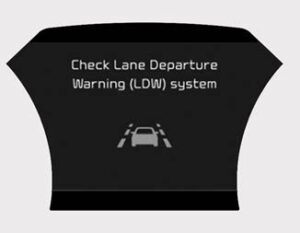
- The LDW failure indicator(yellow) will illuminate if the LDW is not working properly. Take your vehicle to an authorized Kia dealer and have the system checked.
The LDW does not operate when:
- The driver turns on the turn signal to change lanes or operates the hazard warning flasher.
Driving on the lane marker.
NOTICE
Always operate the turn signal before changing lanes.
Limitations of the system
The LDW may not warn you even if the vehicle leaves the lane, or may warn you even if the vehicle does not leave the lane when recognition of the lane marker is poor or limited:
When lane and road condition is poor
- It is difficult to distinguish the lane marker when the lane marker is covered with dust, sand or other factors.
It is difficult to distinguish the color of the lane marker from road.
There is something looks like a lane marker.
The lane marker is indistinct or damaged. - There are more than two lane markers.
The lane marker is very thick or thin.
The lane marker is not visible due to snow, rain, stain, a puddle or other factors.
A shadow is on the lane marker because of a median strip, guardrail, noise barriers and others.
When the lane markers are complicated or a structure substitutes for the lines such as a construction area.
There are crosswalk signs or other symbols on the road.
The lane suddenly disappears such as at the intersection.
The lane marker in a tunnel is covered with dirt or oil and etc.
When external conditions intervene
- The brightness outside changes suddenly when entering/exiting a tunnel or passing under a bridge.
The headlamps are not on at night or in a tunnel, or light level is low.
There is a boundary structure in the roadway.
Light reflects from the water on the road.
When light shines brightly in the reverse direction you drive.
The distance from the vehicle ahead is very short or the vehicle ahead drives hiding the lane line.
You drive on a steep grade or a sharp curve.
The vehicle vibrates heavily.
The temperature near the inside rearview mirror is very high due to direct sun light and etc.
When front visibility is poor
- The lens or windshield is covered by foreign materials.
The sensor cannot detect the lane because of fog, heavy rain or snow.
The windshield is fogged by humid air in the vehicle.
This device complies with Part 15 of the FCC rules.
Operation is subject to the following two conditions:
- This device may not cause harmful interference, and
- This device must accept any interference received, including interference that may cause undesired operation.
ECONOMICAL OPERATION
Your vehicle’s fuel economy depends mainly on your style of driving, where you drive and when you drive.
Each of these factors affects how many miles (kilometers) you can get from a gallon (liter) of fuel. To operate your vehicle as economically as possible, use the following driving suggestions to help save money in both fuel and repairs:
- Drive smoothly. Accelerate at a moderate rate. Don’t make “jack-rabbit” starts or full-throttle shifts and maintain a steady cruising speed. Don’t race between stop-lights. Try to adjust your speed to the traffic so you don’t have to change speeds unnecessarily. Avoid heavy traffic whenever pos-sible. Always maintain a safe distance from other vehicles so you can avoid unnecessary braking. This also reduces brake wear.
Drive at a moderate speed. The faster you drive, the more fuel your vehicle uses. Driving at a moderate speed, especially on the highway, is one of the most effective ways to reduce fuel consumption. - Don’t “ride” the brake pedal. This can increase fuel consumption and also increase wear on these components. In addition, driving with your foot resting on the brake pedal may cause the brakes to overheat, which reduces their effectiveness and may lead to more serious con-sequences.
Take care of your tires. Keep them inflated to the recommended pressure. Incorrect inflation, either too much or too little, results in unnecessary tire wear. Check the tire pressures at least once a month.
Be sure that the wheels are aligned correctly. Improper alignment can result from hitting curbs or driving too fast over irregular surfaces. Poor alignment causes faster tire wear and may also result in other problems as well as greater fuel consumption. - Keep your vehicle in good condition. For better fuel economy and reduced maintenance costs, maintain your vehicle in accordance with the maintenance schedule in section 7. If you drive your vehicle in severe conditions, more frequent maintenance is required (see section 7 for details).
Keep your vehicle clean. For maxi-mum service, your vehicle should be kept clean and free of corrosive materials. It is especially important that mud, dirt, ice, etc. not be allowed to accumulate on the underside of the vehicle. This extra weight can result in increased fuel consumption and also contribute to corrosion.
Travel lightly. Don’t carry unnecessary weight in your vehicle. Weight reduces fuel economy.
Don’t let the engine idle longer than necessary. If you are waiting (and not in traffic), turn off your engine and restart only when you’re ready to go. - Remember, your vehicle does not require extended warm-up. After the engine has started, allow the engine to run for 10 to 20 seconds prior to placing the vehicle in gear. In very cold weather, however, give your engine a slightly longer warm-up period.
Don’t “lug” or “over-rev” the engine. Lugging is driving too slowly in a very high gear resulting in engine bucking. If this happens, shift to a lower gear. Over-revving is racing the engine beyond its safe limit. This can be avoided by shifting at the recommended speed.
Use your air conditioning sparingly. The air conditioning system is operated by engine power so your fuel economy is reduced when you use it.
Open windows at high speeds can reduce fuel economy.
Fuel economy is less in crosswinds and headwinds. To help offset some of this loss, slow down when driving in these conditions.
Keeping a vehicle in good operating condition is important both for economy and safety. Therefore, have an authorized Kia dealer perform scheduled inspections and maintenance.
WARNING
Engine off during motion
Never turn the engine off to coast down hills or anytime the vehicle is in motion. The power steering and power brakes will not function properly without the engine running. In addition, turning off the ignition while driving could engage the steering wheel lock resulting in loss of vehicle steering. Keep the engine on and downshift to an appropriate gear for engine braking effect.
SPECIAL DRIVING CONDITIONS
Hazardous driving conditions
When hazardous driving conditions are encountered such as water, snow, ice, mud, sand, or similar hazards, follow these suggestions:
- Drive cautiously and allow extra distance for braking.
Avoid sudden braking or steering.
When braking with non-ABS brakes pump the brake pedal with a light up-and-down motion until the vehicle is stopped.
Do not pump the brake pedal on a vehicle equipped with ABS.
- If stalled in snow, mud, or sand, use second gear. Accelerate slowly to avoid spinning the drive wheels.
- Use sand, rock salt, or other non-slip material under the drive wheels to provide traction when stalled in ice, snow, or mud.
WARNING
Downshifting
Do not downshift with an automatic transmission while driving on slippery surfaces. The sudden change in tire speed could cause the tires to skid and result in an accident.
Reducing the risk of a rollover
This multi-purpose passenger vehicle is defined as a Crossover Utility Vehicle (CUV). CUV’s have higher ground clearance and a narrower track to make them capable of per-forming in a wide variety of off-road applications. Specific design characteristics give them a higher center of gravity than ordinary vehicles. An advantage of the higher ground clearance is a better view of the road, which allows you to anticipate problems. They are not designed for cornering at the same speeds as conventional passenger vehicles, any more than low-slung sports vehicles are designed to perform satisfactorily in off-road conditions. Due to this risk, driver and passengers are strongly recommended to buckle their seat belts. In a rollover crash, an unbelted person is more likely to die than a person wearing a seat belt. There are steps that a driver can make to reduce the risk of a rollover.
If at all possible, avoid sharp turns or abrupt maneuvers, do not load your roof rack with heavy cargo, and never modify your vehicle in any way.
WARNING
Rollover
Failure to operate this vehicle correctly may result in loss of control, an accident or vehicle rollover.
- Utility vehicles have a significantly higher rollover rate than other types of vehicles.
Specific design characteristics (higher ground clearance, narrower track, etc.) give this vehicle a higher center of gravity than ordinary vehicles.
A CUV is not designed for cornering at the same speeds as conventional vehicles.
Avoid sharp turns or abrupt maneuvers. - In a rollover crash, an unbelted person is significantly more likely to die than a per-son wearing a seat belt. Make sure everyone in the vehicle is properly buckled up.
WARNING
Your vehicle is equipped with tires designed to provide safe ride and handling capability. Do not use a size and type of tire and wheel that is different from the one that is originally installed on your vehicle. It can affect the safety and performance of your vehicle, which could lead to steering failure or rollover and serious injury.
When replacing the tires, be sure to equip all four tires with the tire and wheel of the same size, type, tread, brand and load-carrying capacity. If you nevertheless decide to equip your vehicle with any tire/wheel combination not recommended by Kia for off road driving, you should not use these tires for highway driving.
Rocking the vehicle
If it is necessary to rock the vehicle to free it from snow, sand, or mud, first turn the steering wheel right and left to clear the area around your front wheels. Then, shift back and forth between R (Reverse) and any forward gear in vehicles equipped with an Automatic Transmission. Do not race the engine, and spin the wheels as little as possible. If you are still stuck after a few tries, have the vehicle pulled out by a tow vehicle to avoid engine overheating and possible damage to the transmission.
CAUTION
Vehicle rocking
Prolonged rocking may cause engine overheating, transmission damage or failure, and tire damage.
CAUTION
Spinning tires
Do not spin the wheels, especially at speeds more than 35 mph (56 km/h). Spinning the wheels at high speeds when the vehicle is stationary could cause a tire to overheat which could result in tire damage that may injure bystanders.
The ESC system should be turned OFF prior to rocking the vehicle.
WARNING
Sudden vehicle movement
Do not attempt to rock the vehicle if people or objects are near-by. The vehicle may suddenly move forward or backwards as it becomes unstuck.
Smooth cornering
Avoid braking or gear changing in corners, especially when roads are wet. Ideally, corners should always be taken under gentle acceleration. If you follow these suggestions, tire wear will be held to a minimum.
Driving at night
Because night driving presents more hazards than driving in the daylight, here are some important tips to remember:
- Slow down and keep more distance between you and other vehicles, as it may be more difficult to see at night, especially in areas where there may not be any street lights.
- Adjust your mirrors to reduce the glare from other driver’s head-lights.
Keep your headlights clean and properly aimed. (On vehicles not equipped with the automatic head-light aiming feature.) Dirty or improperly aimed headlights will make it much more difficult to see at night.
Avoid staring directly at the head-lights of oncoming vehicles. You could be temporarily blinded, and it will take several seconds for your eyes to readjust to the darkness.
Driving in the rain
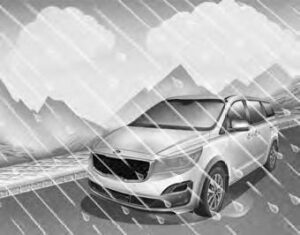
- Rain and wet roads can make driving dangerous, especially if you’re not prepared for the slick pavement. Here are a few things to consider when driving in the rain:
- A heavy rainfall will make it harder to see and will increase the distance needed to stop your vehicle, so slow down.
Keep your windshield wiping equipment in good shape. Replace your windshield wiper blades when they show signs of streaking or missing areas on the windshield.
If your tires are not in good condition, making a quick stop on wet pavement can cause a skid and possibly lead to an accident. Be sure your tires are in good shape.
Turn on your headlights to make it easier for others to see you.
Driving too fast through large puddles can affect your brakes. If you must go through puddles, try to drive through them slowly.
If you believe you may have gotten your brakes wet, apply them lightly while driving until normal braking operation returns.
Driving in flooded areas
Avoid driving through flooded areas unless you are sure the water is no higher than the bottom of the wheel hub. Drive through any water slowly. Allow adequate stopping distance because brake performance may be affected.
After driving through water, dry the brakes by gently applying them several times while the vehicle is moving slowly.
Driving on unpaved roads
Drive carefully on unpaved roads because your vehicle may be dam-aged by rocks or roots of trees. Become familiar with the unpaved road conditions where you are going to drive before you begin driving.
Highway driving
Tires
Adjust the tire inflation pressures to specification. Low tire inflation pressures will result in overheating and possible failure of the tires.
Avoid using worn or damaged tires which may result in reduced traction or tire failure.
Never exceed the maximum tire inflation pressure shown on the tires.
WARNING
Under/over inflated tires
Always check the tires for proper inflation before driving. Underinflated or overinflated tires can cause poor handling, loss of vehicle control, and sudden tire failure leading to accidents, injuries, and even death. For proper tire pressures, refer to “Tires and wheels” in chapter 8.
WARNING
Tire tread
Always check the tire tread before driving your vehicle. Worn-out tires can result in loss of vehicle control. Worn-out tires should be replaced as soon as possible. For further information and tread limits, refer to “Tires and wheels” in chapter 7.
Fuel, engine coolant and engine oil
High speed travel consumes more fuel than urban motoring. Do not for-get to check both the engine coolant and engine oil.
Drive belt
A loose or damaged drive belt may result in overheating of the engine.
WINTER DRIVING
Severe weather conditions in the winter result in greater wear and other problems. To minimize the problems of winter driving, you should follow these suggestions:
Snowy or icy conditions
To drive your vehicle in deep snow, it may be necessary to use snow tires or to install tire chains on your tires. If snow tires are needed, it is necessary to select tires equivalent in size and type of the original equipment tires. Failure to do so may adversely affect the safety and handling of your vehicle. Furthermore, speeding, rapid acceleration, sudden brake applications, and sharp turns are potentially very hazardous practices.
During deceleration, use engine braking to the fullest extent. Sudden brake applications on snowy or icy roads may cause skids to occur. You need to keep sufficient distance between the vehicle in operation in front of your vehicle. Also, apply the brake gently. It should be noted that installing tire chains on the tire will provide a greater driving force, but will not prevent side skids.
Tire chains are not legal in all states. Check state laws before fitting tire chains.
Snow tires
If you mount snow tires on your vehicle, make sure they are radial tires of the same size and load range as the original tires. Mount snow tires on all four wheels to balance your vehicle’s handling in all weather conditions. Keep in mind that the traction provided by snow tires on dry roads may not be as high as your vehicle’s original equipment tires .You should drive cautiously even when the roads are clear. Check with the tire dealer for maximum speed recommendations.
Do not install studded tires without first checking local, state and municipal regulations for possible restrictions against their use.
WARNING
Snow tire size
Snow tires should be equivalent in size and type to the vehicle’s standard tires. Otherwise, the safety and handling of your vehicle may be adversely affected.
Tire chains

- Since the sidewalls of radial tires are thinner, they can be damaged by mounting some types of snow chains on them. Therefore, the use of snow tires is recommended instead of snow chains. Do not mount tire chains on vehicles equipped with aluminum wheels; snow chains may cause damage to the wheels. If snow chains must be used, use wire-type chains with a thickness of less than 0.59 in (15 mm). Damage to your vehicle caused by improper snow chain use is not covered by your vehicle manufacturers warranty.
- When using tire chains, install them on the front tires only.
CAUTION
Snow chains
Make sure the snow chains are the correct size and type for your tires. Incorrect snow chains can cause damage to the vehicle body and suspension and may not be covered by your vehicle manufacturer warranty.
Chain installation
When installing chains, follow the manufacturer’s instructions and mount them as tightly as you can. Drive slowly with chains installed. If you hear the chains contacting the body or chassis, stop and tighten them. If they still make contact, slow down until it stops. Remove the chains as soon as you begin driving on cleared roads.
When mounting snow chains, park the vehicle on level ground away from traffic. Turn on the vehicle Hazard Warning flashers and place a triangular emergency warning device behind the vehicle if available. Always place the vehicle in P (Park), apply the parking brake and turn off the engine before installing snow chains.
- The use of chains may adversely affect vehicle handling.
Do not exceed 20 mph (30 km/h) or the chain manufacturer’s recommended speed limit, whichever is lower.
Drive carefully and avoid bumps, holes, sharp turns, and other road hazards, which may cause the vehicle to bounce.
Avoid sharp turns or locked-wheel braking.
CAUTION
Snow chains
- Chains that are the wrong size or improperly installed can damage your vehicle’s brake lines, suspension, body and wheels.
Stop driving and retighten the chains any time you hear them hitting the vehicle.
Use high quality ethylene glycol coolant
Your vehicle is delivered with high quality ethylene glycol coolant in the cooling system. It is the only type of coolant that should be used because it helps prevent corrosion in the cooling system, lubricates the water pump and prevents freezing. Be sure to replace or replenish your coolant in accordance with the maintenance schedule in section 7. Before winter, have your coolant tested to assure that its freezing point is sufficient for the temperatures anticipated during the winter.
Check battery and cables
Winter puts additional burdens on the battery system. Visually inspect the battery and cables as described in chapter 7. The level of charge in your battery can be checked by an authorized Kia dealer or a service station.
Change to “winter weight” oil if necessary
In some climates it is recommended that a lower viscosity “winter weight” oil be used during cold weather. See chapter 8 for recommendations. If you aren’t sure what weight oil you should use, consult an authorized Kia dealer.
Check spark plugs and ignition system
Inspect your spark plugs as described in chapter 7 and replace them if necessary. Also check all ignition wiring and components to be sure they are not cracked, worn or damaged in any way.
To keep locks from freezing
To keep the locks from freezing, squirt an approved deicer fluid or glycerine into the key opening. If a lock is covered with ice, squirt it with an approved de-icing fluid to remove the ice. If the lock is frozen internally, you may be able to thaw it out by using a heated key. Handle the heated key with care to avoid injury.
Use approved window washer anti-freeze in system
To keep the water in the window washer system from freezing, add an approved window washer anti-freeze solution in accordance with instructions on the container. Window washer anti-freeze is available from an authorized Kia dealer and most auto parts outlets. Do not use engine coolant or other types of anti-freeze as these may damage the paint finish.
Don’t let your parking brake freeze
Under some conditions your parking brake can freeze in the engaged position. This is most likely to happen when there is an accumulation of snow or ice around or near the rear brakes or if the brakes are wet. If there is a risk the parking brake may freeze, apply it only temporarily while you put the gear shift lever in P (Park, Automatic Transmission) and block the rear wheels so the vehicle cannot roll. Then release the parking brake.
Don’t let ice and snow accumulate underneath
Under some conditions, snow and ice can build up under the fenders and interfere with the steering. When driving in severe winter conditions where this may happen, you should periodically check underneath the vehicle to be sure the movement of the front wheels and the steering components are not obstructed.
Carry emergency equipment
Depending on the severity of the weather, you should carry appropriate emergency equipment. Some of the items you may want to carry include tow straps or chains, flash-light, emergency flares, sand, shovel, jumper cables, window scraper, gloves, ground cloth, coveralls, blanket, etc.
FAQs
Blind-spot Collision Warning (BCW) is a Kia Sedona 2020 safety feature that alerts the driver to vehicles in their blind spots.
BCW monitors the areas alongside and behind the vehicle using sensors or cameras. When a vehicle enters the blind spot zone, the system alerts the driver visually or audibly.
The Kia Sedona 2020’s BCW typically provides visual alerts on the side mirrors or instrument cluster, as well as audible warnings, to alert the driver of a potential collision.
BCW detects and alerts the driver to other vehicles in the blind spot. It may, however, fail to detect pedestrians, cyclists, or stationary objects.
The Kia Sedona 2020’s BCW is intended to operate at a variety of speeds, typically above a certain threshold, such as 20 mph (32 km/h).
Yes, the BCW feature can usually be enabled or disabled via the vehicle’s settings or controls, giving the driver the option to use it or not.
No, the BCW is an additional safety aid that does not replace the driver’s need to visually check blind spots before changing lanes or performing maneuver.
While BCW can help detect vehicles in blind spots, it cannot prevent all collisions. The driver must remain alert and use the system as a supplement to safe driving practices.
The Kia Sedona 2020’s BCW is designed to function in a variety of lighting and weather conditions. However, reduced visibility may have an impact on its performance.
The sensitivity of the BCW system in some Kia Sedona 2020 models may be adjustable. Check the owner’s manual or the vehicle’s settings to see if this feature is available.
The BCW is usually active when the vehicle is in motion, but it may have limitations or be disabled in certain situations. For more information, consult the owner’s manual.
The BCW is primarily concerned with vehicles entering the blind spot zones on the vehicle’s sides. It might not give specific warnings to vehicles approaching from behind.
Yes, the BCW is intended to detect vehicles in adjacent lanes relatively quickly, providing the driver with timely alerts.
No, the BCW does not eliminate the need for turn signals. Before changing lanes, it is critical to use turn signals and visually check for blind spots.
Useful Links
View Full User Guide: Kia Sedona User Manual | Auto User Guide
Download Manuals: Owner’s Manuals and Documents | Kia

